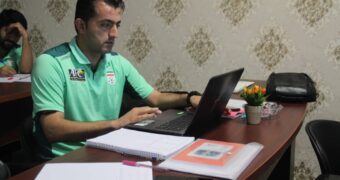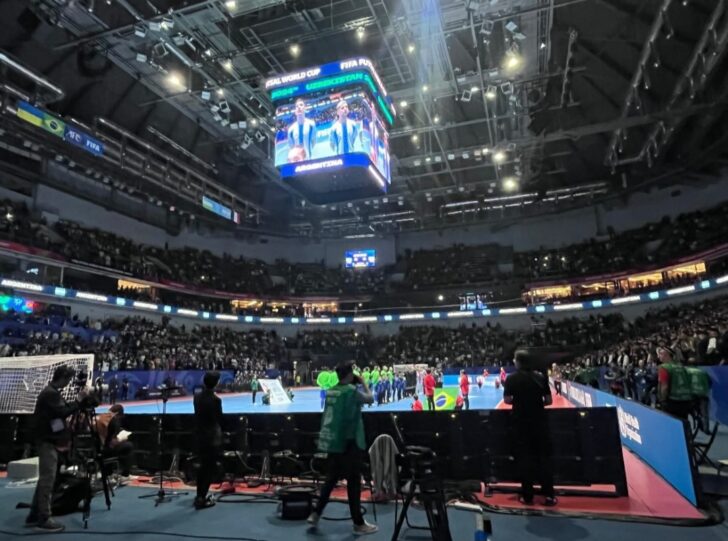Estimated reading time:10 minutes, 3 seconds
Uzbekistan raises the bar for futsal’s global growth, as FIFA faces a pivotal moment to shift from development to broader commercial ambitions.
The 2024 FIFA Futsal World Cup has come to a thrilling end, delivering a rollercoaster of emotions and unexpected twists, particularly in the final stages of the tournament. Brazil emerged victorious, claiming their sixth championship title—their first in 12 years. This remarkable achievement is a testament to the hard work and dedication of head coach Marquinhos Xavier, his coaching staff, the players, and the passionate Brazilian fans who supported them every step of the way.
Credit must also be given to FIFA and Uzbekistan for delivering an outstanding tournament. They not only increased fan attendance but created an atmosphere of exceptional hospitality and vibrancy around the competition. This helped alleviate the frustrations left by previous hosts Lithuania and Colombia. Uzbekistan has now set a new standard for future hosts to replicate—and hopefully improve upon—as the competition continues to grow in both scale and excitement. Their significant investment in futsal infrastructure brought the sport closer to people, making it more accessible, and ensuring a lasting legacy.
Uzbekistan’s Futsal Legacy: A Foundation for the Future
Uzbekistan’s efforts extend far beyond hosting a successful tournament. Thanks to unprecedented investments, the country is seeing the development of new halls, training facilities, and grassroots programs. The 2024 FIFA Futsal World Cup has sparked several major projects, including the construction of two new multi-sport complexes in Bukhara and Andijan, each seating 3,500 fans and hosting key matches. Additionally, three wooden and seven rubber pitches have been installed in both competition and training venues, nurturing the development of young talent.
Upgraded facilities, including modernized changing rooms, floodlights, and safety measures, now meet international standards, while FIFA-certified goalposts and scoreboards have contributed to the tournament’s success. These improvements not only ensure a higher quality of play but also create a foundation for the long-term development of futsal in Uzbekistan and beyond, making the sport more accessible to a wider audience and fostering a more competitive national team.
Development or Commercialization? The Futsal Dilemma
With Uzbekistan’s success in both development and infrastructure, this raises the central theme of this article: while development has been the focus of FIFA’s futsal strategy for the past 36 years, is it time to shift toward commercialization? Recent milestones, such as the introduction of official FIFA rankings for men’s and women’s futsal and the upcoming inaugural Women’s Futsal World Cup in the Philippines, suggest the sport is evolving. However, commercialization could unlock further growth and global appeal.
A critical next step for FIFA is to update the outdated global participation statistic of 30 million players, a figure that has been used for years. Based on our research engaging with associations around the world, this figure falls short of the reality. Conducting an official global participation survey and publishing the findings would provide a clearer picture of the sport’s growth, impact, and potential audience, which would support FIFA’s future commercialization strategies.
Historical Overview of Futsal Hosts and FIFA’s Development Strategy
Since its inception in 1989, the Men’s FIFA Futsal World Cup has primarily been hosted in countries where development was the primary motivator. A brief overview highlights this strategy:
- 1989 – Netherlands: The inaugural tournament aimed to promote futsal in Europe, where indoor football was still growing.
- 1992 – Hong Kong: This marked a geographic expansion to Asia, introducing futsal to a wider audience.
- 1996 – Spain: Capitalized on futsal’s growing popularity in Southern Europe, focusing on commercial growth alongside development.
- 2000 – Guatemala: Fostered futsal’s growth in Latin America, a region well-suited to urban-based sports like futsal.
- 2004 – Chinese Taipei: Further expanded futsal’s reach in East Asia.
- 2008 – Brazil: Showcased the sport’s maturity in a futsal powerhouse, blending development and commercial growth.
- 2012 – Thailand: Continued the push into Asia, where futsal infrastructure was improving.
- 2016 – Colombia: Encouraged Latin American development, following the strategy used in Guatemala.
- 2021 – Lithuania: Focused on expanding futsal in Eastern Europe.
- 2024 – Uzbekistan: Aimed at developing futsal infrastructure in Central Asia, with a focus on youth development.
While these choices have been primarily development-focused, the increasing maturity of futsal suggests that now may be the time for FIFA to consider a stronger emphasis on commercial growth.
Why Commercialization Matters Now
Over the past three decades, futsal has evolved from a niche sport to a globally recognized game with a substantial player base, professional leagues, and an enthusiastic fan following. UEFA’s decision to choose Latvia and Lithuania for the 2026 UEFA Futsal Euro over commercially viable countries like France indicates that the focus on development still takes precedence. However, the time might be right to explore commercialization more seriously. Here’s why:
- Growing Fan and Player Base: Countries like Brazil, Portugal, Italy, and Argentina are well-established in the futsal world with professional leagues that attract significant fan engagement. Spain also has a thriving futsal scene, though its league has not yet achieved full professional status despite being one of the strongest globally. Meanwhile, the sport is rapidly expanding in other regions. In Asia, Japan and Iran have emerged as dominant futsal powerhouses, while Indonesia and Malaysia are witnessing notable growth in player development and fan participation, further contributing to futsal’s growing popularity. In Europe, both France and Germany are making significant strides in futsal development. France has qualified for its first-ever FIFA Futsal World Cup in 2024, marking a major milestone. The country’s D1 Futsal League is expanding, now featuring 12 teams, with growing attendance—some events even selling out with over 3,000 spectators. Africa is also seeing futsal’s rise, especially in Morocco and Angola. Morocco has established itself as a powerhouse in African and Muslim futsal, highlighted by its victory over Iran in the World Cup and its successful hosting of the African qualifiers, setting a new benchmark for competition delivery on the continent. Angola is another exciting prospect. Its national team draws large home crowds, and with plans to launch a professional futsal league, Angola could further boost its futsal infrastructure. Hosting future events, such as the FIFA Futsal World Cup, could accelerate these developments. This global spread of talent and enthusiasm demonstrates futsal’s increasing visibility and potential for further commercial ventures across diverse markets.
- Broadcasting and Media Interest: Media coverage for futsal has grown, particularly during major tournaments. This suggests a market for futsal content that FIFA and its Confederations can tap into by hosting events in more commercially viable locations, such as Western Europe or Asia.
- Sponsorship and Commercial Potential: Futsal’s fast-paced and skill-based nature appeals to younger, urban audiences, making it ideal for TV broadcasts and sponsorship deals. By focusing on commercialization, FIFA could generate revenue streams from sponsorships, media rights, and merchandise sales that could be reinvested into further developing the sport.
Missed Commercial Opportunities in Major Football Markets
By consistently choosing development-focused host nations, FIFA may be missing opportunities to capitalize on the commercial potential of established markets. Hosting a futsal World Cup in countries like France, Italy, Portugal, Germany, Brazil, or Japan could draw significantly higher crowds and media attention. These countries already have futsal communities, and robust football infrastructures and large fanbases, which could seamlessly pivot to futsal.
Suggested Strategies for Transitioning to Commercialization
If FIFA and UEFA are to transition futsal toward commercialization successfully, several strategies could be employed:
- Host Future Tournaments in Major Football Markets: Starting with the 2028 FIFA Futsal World Cup, FIFA could explore commercially appealing markets with well-established infrastructures for hosting large-scale events. In a related development, following the recent Futsal World Cup, FIFA announced plans to recommend futsal for inclusion in the Olympic Games. However, the next Olympics, scheduled for Los Angeles in 2028, may face challenges in supporting futsal’s inclusion. US Soccer’s current lack of emphasis on futsal makes it unlikely to back the sport, and as a result, the host city, LA, is also unlikely to champion its inclusion. However, there remains the potential for futsal to be featured as a demonstration sport in 2028, paving the way for its full inclusion by the 2032 Olympics in Australia. For this to happen, significant efforts will be needed to shift the current stance of the Football Australia, which has yet to prioritize futsal within its broader football strategy
- Integrate Futsal with Major Football Events: Hosting futsal alongside marquee football tournaments, such as the FIFA Men’s or Women’s World Cup or UEFA Champions League finals, would significantly enhance the sport’s visibility. This concept has proven successful in the past, such as when UEFA organized a futsal event outside Wembley Stadium during the UEFA Champions League Final in London, drawing attention to the sport among football fans. Furthermore, major futsal events already feature prominent football advertising, underscoring the shared audience between the two sports. However, the inverse is less common—futsal does not yet receive equal promotion during marquee football tournaments. Integrating futsal into football’s biggest stages, with cross-promotion by governing bodies like FIFA and UEFA, would not only grow futsal’s fan base but also encourage more countries to invest in its development. With futsal gaining traction globally, such initiatives could provide a much-needed boost to the sport’s profile.
- Target Urban Audiences and Youth Programs: Since futsal thrives in urban areas, FIFA should invest in grassroots programs targeting youth in major cities. This will not only build a future talent pool but also create a strong urban fanbase, key to commercial growth.
- Prioritize Futsal Over Other Small-Sided Formats: Convincing associations to prioritize futsal over other small-sided formats (like 5, 6 and 7-a-side football) would consolidate the sport’s role in youth development and technical training, as seen in Germany’s recent reforms.
A Balanced Future for Futsal and Professional Growth
Futsal has reached a critical juncture. While its developmental achievements cannot be overstated, the sport is now mature enough to shift toward commercialization. The strategies suggested here could help FIFA and UEFA unlock futsal’s full potential while ensuring it continues to grow at both grassroots and professional levels.
Commercialization would not only elevate futsal’s global profile but also increase interest in professional futsal leagues and clubs worldwide. As the sport garners more media attention and sponsorship, professional leagues that are striving for recognition will benefit from greater visibility, improved funding, and the opportunity to attract top-tier talent. This influx of investment could help many clubs move toward full professionalism, further improving the quality of competition and the global appeal of futsal.
By promoting professional leagues and clubs, futsal could transition into a sustainable commercial sport, providing new revenue streams for clubs and creating a more robust professional landscape. This would, in turn, generate even more interest from fans, sponsors, and broadcasters, fostering a virtuous cycle of growth and investment.
By 2028, FIFA should aim for host nations that can provide both developmental benefits and the commercial infrastructure needed to elevate futsal. This balance will ensure that the sport continues to thrive, attracting media attention, sponsorship opportunities, and new fans from across the globe. In doing so, it will also support the growth of professional futsal, helping leagues and clubs across the world achieve the professionalism and investment needed to secure the sport’s long-term future.
Organ Donation
Futsal Focus is a supporter of Dáithí Mac Gabhann and his family’s campaign to raise awareness of Organ Donation. We encourage our readers to learn more about Organ Donation: https://www.organdonation.nhs.uk/
Futsal Focus
You can read more articles about International Futsal by going to the top navigation bar or by clicking here
If you like this article and would like to keep updated on Futsal news, developments, etc. You can now follow Futsal Focus via Google News. By following our page which will send you an alert as soon as we publish an article. Please click here and follow us on Google.
You can also keep updated on Futsal news, developments by submitting your email below in the Subscribe to Futsal Focus option.
Follow Futsal Focus by clicking on Facebook, Twitter, or Instagram or on the social media buttons on the website.
















![Validate my RSS feed [Valid RSS]](https://www.futsalfocus.net/wp-content/uploads/2020/01/valid-rss-rogers.png)




